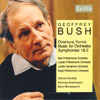Bush, G Orchestral Works
View record and artist detailsRecord and Artist Details
Composer or Director: Geoffrey Bush
Genre:
Orchestral
Label: Lyrita
Magazine Review Date: 3/1996
Media Format: CD or Download
Media Runtime: 79
Mastering:
Stereo
DDD
ADD
Catalogue Number: SRCD252

Tracks:
| Composition | Artist Credit |
|---|---|
| Overture, 'Yorick' |
Geoffrey Bush, Composer
Geoffrey Bush, Composer New Philharmonia Orchestra Vernon Handley, Conductor |
| Music (1967) for orchestra |
Geoffrey Bush, Composer
Geoffrey Bush, Composer London Philharmonic Orchestra Vernon Handley, Conductor |
| Symphony No. 1 |
Geoffrey Bush, Composer
Geoffrey Bush, Composer London Symphony Orchestra Nicholas Braithwaite, Conductor |
| Symphony No. 2, '(The) Guildford' |
Geoffrey Bush, Composer
Barry Wordsworth, Conductor Geoffrey Bush, Composer Royal Philharmonic Orchestra |
Author: Michael Oliver
Most enjoyable, and with a new recording of the Guildford Symphony added to the other reissued pieces, this generously filled disc arrives in the nick of time before Geoffrey Bush’s seventy-fifth birthday year gives way to his seventy-sixth. His style is ‘traditional’, yet not overindebted to any predecessor; certainly not, at least in the orchestral music, to his teacher John Ireland. There is an audible affinity, at times, with Walton in his exuberant vein, once or twice with Constant Lambert (the slow movement of the First Symphony, a lament for Bush’s boyhood hero, gracefully quotes him). Bush’s individuality lies in his sound, which is colourful, rarely lush, sometimes agreeably brusque and brassy (he loves fanfares and sonorous major-key climaxes). This astringency of colour adds zest to his always fluent, generous flow of melody.
His ingenious use of form is personal, too, and when he decides to cast the first movement of the First Symphony as a rondo it is not long before you realize that he has the resource and the dramatic flair to make such a repetitive form eventful. The Second Symphony manages to be a single, extended sonata-form movement and a more or less conventional four-movement symphony at the same time. Yet even when you know (the composer tells you so in advance) that the finale is going to repeat all three themes of the introduction in reverse order, you are sure long before you get there that they will be presented in satisfying new lights. On the way you realize that the same themes, no less ingeniously transformed, have formed the basis of the lyrical slow movement, the nimble scherzo and both its contrasting trios.
There is also what one might call a ‘light music side’ to Geoffrey Bush, exemplified by the cheerful overture Yorick (though with an elegy at its centre) which he wrote in memory of the comedian Tommy Handley. He has the shrewdness not to suppress this aspect of his musical personality when writing symphonies, just as when writing for children in the Music for Orchestra he refuses to patronize them. His is immensely likeable music, and any orchestra programming these pieces would receive gratitude as well as applause. All four orchestras here seem to enjoy themselves a good deal. The reissued recordings sound a little on the thin side, but they have ample colour and impact.'
His ingenious use of form is personal, too, and when he decides to cast the first movement of the First Symphony as a rondo it is not long before you realize that he has the resource and the dramatic flair to make such a repetitive form eventful. The Second Symphony manages to be a single, extended sonata-form movement and a more or less conventional four-movement symphony at the same time. Yet even when you know (the composer tells you so in advance) that the finale is going to repeat all three themes of the introduction in reverse order, you are sure long before you get there that they will be presented in satisfying new lights. On the way you realize that the same themes, no less ingeniously transformed, have formed the basis of the lyrical slow movement, the nimble scherzo and both its contrasting trios.
There is also what one might call a ‘light music side’ to Geoffrey Bush, exemplified by the cheerful overture Yorick (though with an elegy at its centre) which he wrote in memory of the comedian Tommy Handley. He has the shrewdness not to suppress this aspect of his musical personality when writing symphonies, just as when writing for children in the Music for Orchestra he refuses to patronize them. His is immensely likeable music, and any orchestra programming these pieces would receive gratitude as well as applause. All four orchestras here seem to enjoy themselves a good deal. The reissued recordings sound a little on the thin side, but they have ample colour and impact.'
Discover the world's largest classical music catalogue with Presto Music.

Gramophone Digital Club
- Digital Edition
- Digital Archive
- Reviews Database
- Full website access
From £8.75 / month
Subscribe
Gramophone Full Club
- Print Edition
- Digital Edition
- Digital Archive
- Reviews Database
- Full website access
From £11.00 / month
Subscribe
If you are a library, university or other organisation that would be interested in an institutional subscription to Gramophone please click here for further information.




